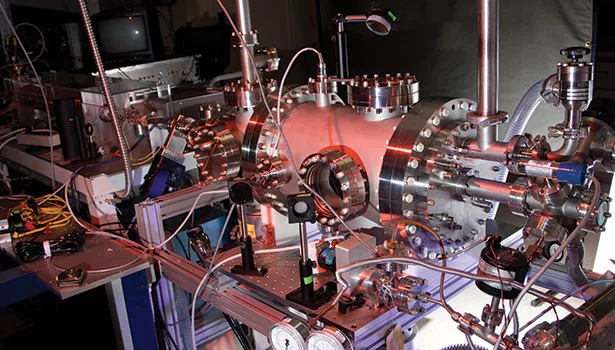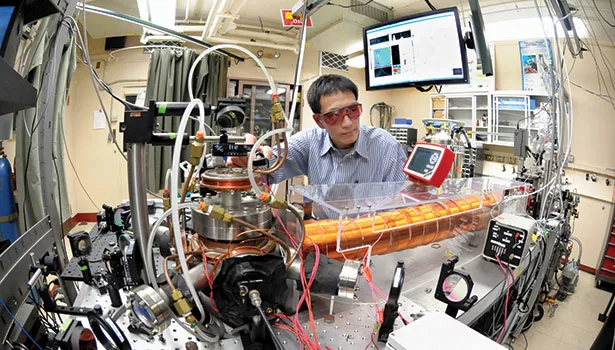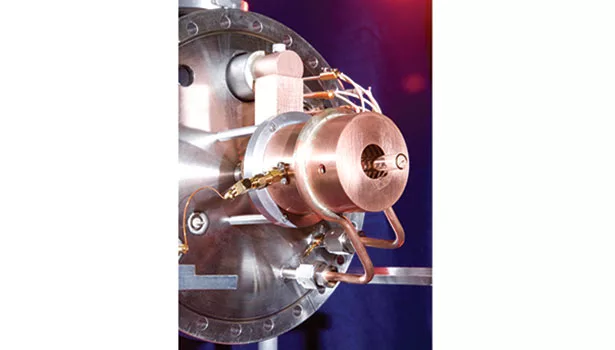Scientists Able to Date Groundwater as Old as 1 Million Years






Article Index:
Tasked with forecasting what human and environmental stress might do to principle aquifers looking 50 or more years into the future, groundwater recharge and sustainability are factors he’s always conscious of.
Groundwater dating is an important step in understanding how much groundwater will be available over the long term, especially important at a time when drought is diminishing above-ground fresh water resources in the U.S. The process involves using isotopes in groundwater to calculate just how long the water has been in the subsurface, comparable to how archeologists use carbon dating with fossils.
“Any time you withdraw water from an aquifer, it changes the dynamics of that aquifer,” Dennehy says. “In very old groundwater, when you’re extracting water you should realize that that water took a long time to get into that location, so it would take a long time to replace that water. So knowing the age of aquifers would give you an idea of how long it took and how valuable that resource is.”
An evolving technique, initiated in the late ’90s by a team of scientists at Argonne National Laboratory in Argonne, Ill., could help groundwater professionals like Dennehy calculate the age of groundwater much older than currently used methods allow.
“We [don’t] have very many techniques for groundwater ages approaching a million years so it seems like, from what I’ve been able to read, a dependable consistent method to measure very old groundwater,” Dennehy says.
Atom Trap Trace Analysis (ATTA) is the pioneering method and krypton-81 is the rare isotope. Zheng-Tian Lu, a scientist at Argonne National Laboratory’s physics division, specializes in the process, which is already helping scientists around the world date very old groundwater. “The oldest groundwater we have found in our laboratory is about 1.2 million years,” Lu says.
Using what he calls first-of-its-kind equipment in his lab, Lu is able to determine the age of such old groundwater by quantifying the concentration of krypton-81 isotopes in a given groundwater sample.
The Process
Krypton-81 is a specific isotope of the krypton atom that is produced by cosmic rays in the earth’s atmosphere and absorbed by water on the surface. As that water seeps underground, so does a small amount of krypton-81. Every 230,000 years, the isotope’s concentration decreases by a factor of two.
“Basically, if you start with 100 krypton-81 atoms in a box, 230,000 years later if you go check there will be around 50. … If you wait another 230,000 years, you check again, there will be around 25. . . So basically we use that as a clock,” Lu says.
Krypton-81 stays in groundwater for around a million years before completely decaying, and can be tracked as it moves through aquifers.
Samples of the isotopes are pumped from water wells into a specialized gas collection machine, called EDGAR (Extraction of Dissolved Gases for Analysis of Radiokrypton), that separates krypton from the rest of the gases present in the water. From the 100 liters of groundwater pumped, Lu ultimately gets 5 microliters of krypton sent to his lab in a small stainless steel tube.
“Imagine every krypton atom is mixed with trillions of krypton atoms that look similar, so how do you sort [krypton-81] out? That’s where our specialty comes in,” he says.
Lu uses a machine he calls an Atom Trap Trace Analysis device to sort through the various types of krypton atoms, then pick out the ones he’s interested in — krypton-81 — and count them. He says only three such apparatuses exist in the world today and his patented machine was the first. It uses laser technology to see the small differences in color of different isotopes that the human eye isn’t capable of processing. When the right isotope of krypton passes by, the laser captures it and sends it to a spot where it glows bright enough for Lu and his team to detect. The instrument is able to report krypton-81 concentrations within a few hours.
From that information, “It’s basically exponential decay,” Lu says. “It’s a very simple formula that can get you the age.”
What It Means
Lu recently helped scientists date groundwater in one of the world’s oldest and largest aquifers, Brazil’s Guarani Aquifer. The research was published in the Nature Geoscience Journal in December 2014.
Pradeep Aggarwal, leader of the research project and section head of isotope hydrology at the International Atomic Energy Agency (IAEA) led the research project and says that while reliable isotopes exist to date younger, more shallow aquifers, determining the age of such ancient groundwater wouldn’t be possible without krypton-81 atom trap technology.
“The question is the deeper the aquifer, the older it is and therefore it requires a tracer that goes far back in time,” he says. “So the Guarani Aquifer that we were working on is about 1,000 meters below ground. … Therefore we need to use tracers that will allow us to look that far behind in time.”
Aggarwal says the oldest sample collected was about 830,000 years old.
In light of groundwater management and regulation, a reliable tool for dating the older aquifers of the world is invaluable, he says. “When we drill a well and we get water out, we can pump as much as the pump will allow us to withdraw. But what we pump in five minutes may have taken hundreds of thousands of years for water to accumulate. If we can quickly measure the age of water, it can give us some idea of how big the aquifer is and how long it takes to renew and recharge. This is information we need to understand how much we can withdraw for how long — the sustainability of the aquifer.”
A number of isotopes exist for dating groundwater, according to Neil Sturchio, chair of the Department of Geological Sciences at the University of Delaware. He’s been collaborating with Lu for several years and was responsible for extracting krypton gases from the groundwater in Aggarwal’s research project. He says there are a handful of isotopes for dating groundwater up to about 60 years old, there is argonne-39 for dating back to about 1,000 years and carbon-14 for about 30,000 years.
Chlorine-36, he says, can date back about as far as krypton-81, but he says, it’s more complicated to work with. “The problem with chlorine-36 is that it’s also produced underground, so you can’t really always determine how much of the chlorine-36 you’re looking at was produced underground versus how much is coming in from the atmosphere and slowly decaying underground. So it just complicates the use of chlorine-36 … establishing krypton-81 as the most reliable method for dating really old groundwater.”
That said, krypton-81 isn’t useful for dating groundwater everywhere because a lot of aquifers used routinely for drinking water are closer to the surface and younger. Sturchio says these sources of groundwater are often tens of thousands of years old at most.
“But when you get into the deeper confined aquifers, there’s a lot of these around the country that are also being heavily used or could be used in the future when the shallower ones are depleted,” Sturchio says. “In many cases there’s no real information available on groundwater ages, so there’d be no way to tell if the water is 10,000 years old and therefore can be replenished fairly quickly, or a million years old and therefore it’s not being replenished quickly. So I think that’s the importance of krypton-81 for groundwater.”
Evolution of Krypton-81 Dating
“This krypton dating idea is not new,” Lu says. “It was actually proposed in the ’60s. So those pioneers of the field proposed krypton dating, but at the time they didn’t have any idea how to detect the atoms in a reasonable quantity sample.”
Aware of past attempts to create a way to actually make krypton dating possible and practical, Lu submitted a proposal when he came to Argonne National Laboratory in 1997 and was fortunate enough to receive funding. “So my colleagues and I started working on [the atom trap technology] and we’ve been doing that ever since.”
What Lu and his team have developed is a new analytical tool that earth scientists around the world use, by collaborating with him, to answer various scientific questions.
The previous generation of the atom trap machine was less capable, requiring much larger samples to get the job done. Now, Lu says the machine is much better. In the last three years his team has entered into 17 collaboration projects and analyzed about 120 samples from every continent.
“It’s the geologists that generate the ideas of where to apply it,” he says. “So our job is to build the instrument and make it even better. By better I mean it needs less and less samples that can be applied more widely around the world.”
Lu says his goal is to build a next generation machine that can handle samples 10 times smaller, making it much easier for geologists to extract them. “Then we want to collaborate with more geologists around the world for our goal, to map the water of the world.”
As the technology’s popularity and capabilities continue to grow, the potential for krypton-81 groundwater dating to be applied as a management tool in the U.S. could soon become a reality.
Sturchio says someday down the road, increased capabilities of determining groundwater’s age could help government officials better understand aquifer recharge rates and factor into how groundwater use is regulated. Since older aquifers take longer to recharge, calculating their age is especially important in sustaining groundwater.
“USGS is really interested in this technique,” Sturchio says. “We had some discussions with them about some kind of a joint facility or something like that. So they’re interested in it.”
Dennehy says the more information on groundwater USGS can obtain, the stronger its understanding of the country’s aquifers will be.
“I personally haven’t used Krypton-81,” Dennehy says. “It looks like a very interesting new tool that would be nice to use actually.”
Valerie King is associate editor of National Driller.
Looking for a reprint of this article?
From high-res PDFs to custom plaques, order your copy today!









